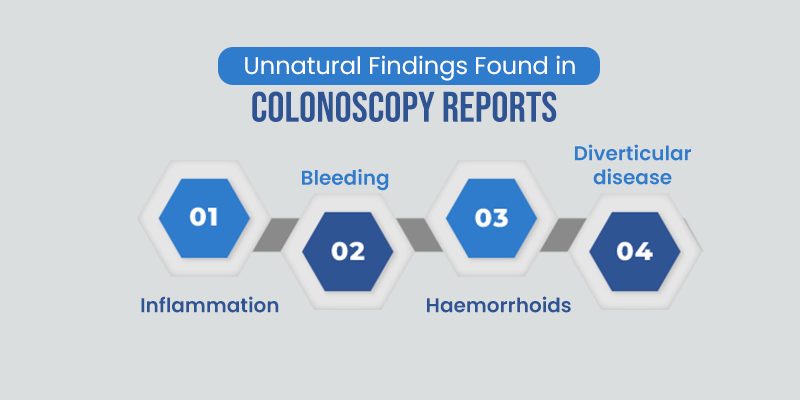- 25th Sep, 2024
- Colonoscopy
What Do Different Findings In Your Colonoscopy Report Mean?
Colon cancer is on the rise among individuals irrespective of their age and gender. Hence, colonoscopy has emerged as a crucial medical tool to let your doctor look for abnormalities in the large intestine. The test is also the most effective way to diagnose other bowel and intestinal conditions like Crohn’s disease and Diverticulitis. The next process which comes after the examination is understanding the results of the test. The test report might either come out as normal or as an indication of a disease.
In this blog, we will get to know about the different findings of a colonoscopy report and what do they signify regarding your health condition.
How Is A Colonoscopy Performed?
A colonoscopy procedure is usually done to identify abnormalities like swollen, irritated tissues, polyps or cancer in the colon and rectum located in the large intestine. The test is done by an experienced colonoscopy doctor who has received advanced training in treating gastrointestinal disease and performing various diagnostic tests.
During the procedure, a long flexible tube with a camera is inserted into the rectum and colon through the anus. Your doctor then monitors the lining of the colon and the rectum. It generally takes about 20-30 minutes to complete the test. To give relief from any kind of discomfort, the patient will also be prescribed painkillers or sedatives to help them relax
What Does The Colonoscopy Report Mean?
Here is a brief guide to understanding the reports of a colonoscopy test.
- Negative
If the findings in your report are negative, it indicates that there are no such abnormalities in your colon. A negative test report also means that your colon is healthy and there is no risk of the development of any kind of cancerous cells. It suggests that you are not required to undergo a colonoscopy for the next 10 years. - Positive
A positive colonoscopy report indicates that there are abnormalities in the lining of your colon. In most cases, polyps get detected which vary in size and can be less than a quarter-inch to several inches. They can also be either flat or with a stalk. Polyps are of different types; most are usually benign but over time some of them can even turn cancerous.
Here are other unnatural findings that can be found in colonoscopy reports.
- Inflammation: Your colon can become inflamed due to various reasons. The common ones include bowel diseases like Crohn’s disease or ulcerative colitis. If your colonoscopy doctor finds that your colon and rectum are irritated, he will conduct additional tests to determine the underlying cause.
- Bleeding: At times, a colonoscopy report even reveals blood in the large intestine. However, the source of the bleeding cannot be found by this examination. In that case, further tests are done to identify the tumour or abnormal collection of the blood vessels.
- Haemorrhoids: These are swollen veins that develop near the surface of the rectum. Haemorrhoids are usually found in patients who experience rectal bleeding. They are not cancerous and can be treated effectively. However, they cause annoyance with symptoms such as itching and pain.
- Diverticular disease: They are couch-like structures that form on the muscular walls of the colon and usually bulge outward. Diverticula are mostly harmless and often go unnoticed. However, if the colonoscopy report detects two or more diverticula which are either inflamed or infected, then it may suggest a condition known as diverticulitis which results in a sudden and dull ache in the abdomen.

Conclusion
Understanding a colonoscopy report is not as complicated as it seems to be. All you need to consult a certified colonoscopy doctor who can accurately predict the findings and know how to treat the conditions.